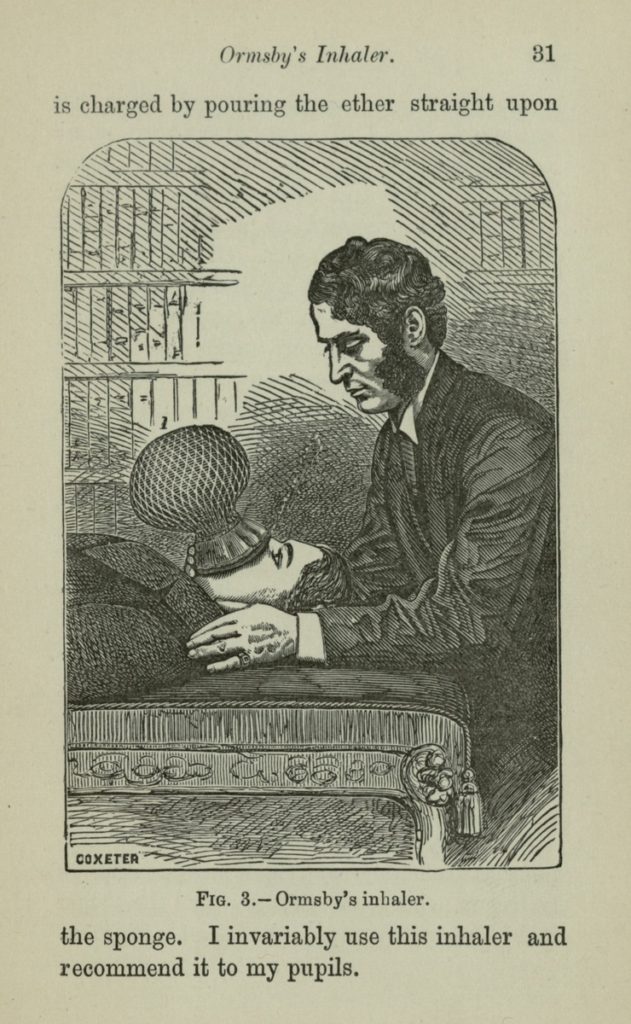It’s spring, and that means rhubarb! From strawberry rhubarb pie, to custard, to gin, this vegetable (most often used like a fruit) is either loved or hated by people the world over. Like many plants, rhubarb has been used medicinally for centuries, especially in traditional Chinese medicine. While the various species of rhubarb, and their distribution from Asian countries across the globe have been researched and discussed at length (see Sources and further reading for more), this post will examine the various types of rhubarb and their medicinal uses found in some of the Library’s herbals.
History of medicine
Ether in Surgery
– by Josh Bicker, Visitor Services Floor Supervisor
A curious image from our Digital Image Library portrays two men, one of them lying on his back, with a ribbed, balloon like structure over his nose and mouth, as another man looks on, holding the balloon like structure on to his face. From the text around the image, we can tell this is Ormsby’s Inhaler, a variant of a number of different inhalers used at the time for administering Ether as an anesthesia for a patient undergoing surgery. This image is from a general anesthesia guide created by Henry Davis from 1892.
Commitment
– by Wood Institute travel grantee Maureen Cummins*
I spent a fascinating week this past summer at the Historical Medical Library of the College of Physicians of Philadelphia conducting research for a limited-edition artist’s book, Commitment. Like many of my titles, Commitment is a double-entendre, referring both to a marital or romantic bond and hospitalization for insanity. Suffice to say, the project explores the connection between intimate human relationships and mental illness.
Read more
Medical Schools and Their Reputations, a Concern both Past and Present
– by Wood Institute travel grantee Laura Smith*
On November 1, 1874, Dr. James H. Lenow procured the cadaver of an African American man from the state penitentiary in Arkansas and began dissecting it in a shed at the Little Rock Barracks, a military facility. Lenow would become an early faculty member at what would eventually be known as the University of Arkansas Medical School (UAMS) which was also located in Little Rock. The story of the dissection gave him prestige among the city’s residents and inspired local confidence in a growing medical status in the South. Lenow’s was the first legal dissection in Arkansas, and the state was so mesmerized by the deed that they built a monument to the dissection in May of 1927 on the spot it took place. The monument still stands today.
Digitizing early medical education
We are pleased to announce that over 20,000 pages of lecture notes and related material has been digitized to date as part of “For the Health of the New Nation” grant. “For the Health of the New Nation: Philadelphia as the Center of American Medical Education, 1746-1868” is a two-year project funded by CLIR and organized by the Philadelphia Area Consortium for Special Collections Libraries (PACSCL). The initiative will digitize, describe, and provide access to 140,000 pages of lecture tickets, course schedules, theses, dissertations, student notes, faculty lectures notes, commencement addresses, opening addresses, and matriculation records, sharing not only the voices of the medical greats, but also the often unheard voices of students.
Quakers All the Way Down: Lunacy & the Society of Friends in Early Philadelphia
– by Wood Institute travel grantee Sharlene Walbaum, Ph.D.*
Imagine this: it is 1750. You work a farm near Philadelphia. Your child, now a young adult, hears disturbing voices, is suspicious and fearful, and sometimes lashes out violently. It is terrible and sad. You feel the weight of responsibility to your child and to others. What are your choices? There are no emergency rooms, mental health care clinics, psychotherapists, or antipsychotic medications.
Families and communities were responsible for someone experiencing mental illness, although the ways in which that obligation was met seem cruel today. If the person was dangerous to self or others, he or she might live chained in a shed or a hole dug in the earthen floor of the kitchen that was covered with a grating. Or, he or she might face a potentially worse fate – jail or the almshouse. If danger was not a concern, he or she might be left to wander out of doors and depend on the kindness of neighbors. Confinement, incarceration, homelessness – how different are options today?
Bad Blood: Nineteenth-Century Anti-Vaccination Rhetoric
– by Wood Institute Travel Grantee Elena Jarmoskaite*
It was in the scorching heat of summer 2018 that I arrived in Philadelphia, having travelled some three and a half thousand miles separating the Historical Medical Library and my home in London. I came here for the sole purpose of learning more about the phenomenon most of us would happily never hear about again: the anti-vaccinationists, or, colloquially, the anti-vaxxers.
Not that long ago I would have seen vaccination opponents as a merely baffling movement, perhaps not all that distinctly removed from other fringe groups like the infamous flat-earthers or tin foil-hat-wearers; at the point of my visit, however, they had become central to my Master thesis. A lot has been said about the anti-vaccinationists, and it is an increasingly hot topic at the moment, with unfortunate and unignorable outbreaks of vaccine-preventable diseases happening all over the globe. Vaccination opposition, however, is a difficult subject, both because of its multi-layered nature, and because of the immense amount of emotion surrounding it.

